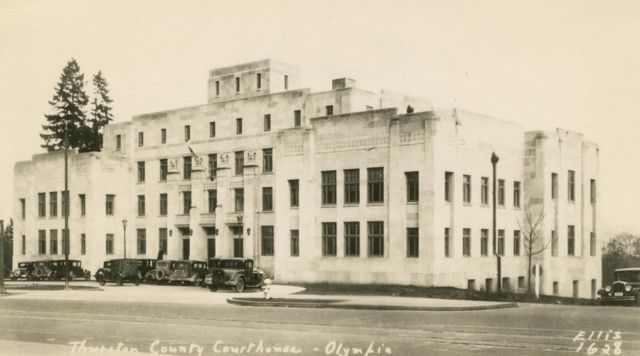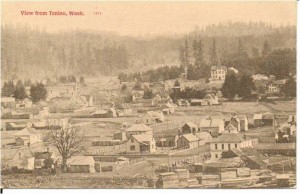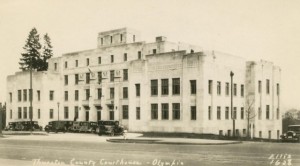
By Drew Crooks
![]() Tenino is currently a town of slightly over 1,700 inhabitants in the south central section of Thurston County. Mystery surrounds the origins of its name. For thousands of years Native Americans lived in the area. According to one pioneer account, the Nisqually Indian name for the site that later became Tenino was “Kla-pe-ad-am.”
Tenino is currently a town of slightly over 1,700 inhabitants in the south central section of Thurston County. Mystery surrounds the origins of its name. For thousands of years Native Americans lived in the area. According to one pioneer account, the Nisqually Indian name for the site that later became Tenino was “Kla-pe-ad-am.”

American settlers came to the region in the mid-19th century. Stephen Hodgden in 1852 took up a land claim on the eastern part of what is presently the Town of Tenino. Shortly afterwards Sam Davenport, another pioneer, settled on the western section of the future community. Stephen’s property became a stop on the stagecoach line to Olympia by the 1860s. It was called Hodgden’s Station.
The entire area where Tenino is now located was for a time known as Coal Bank, named after a local coal outcrop. Indeed, a post office called Coal Bank was established in the current Tenino area on April 17, 1860 with Stephen Hodgden serving as the first postmaster. The area’s County voting precinct and first school also had the name of Coal Bank.
Change swept the region with the coming of the Northern Pacific Railroad in the early 1870s. In October 1872 the last spike was driven in on the part of the track that led northward to Hodgden’s Station. Northern Pacific built a railroad office-depot at the spot and named it “Tenino.” The next year the railroad line was extended on to its terminus at Tacoma on Commencement Bay. Behind in Tenino a small village was created with the construction of a hotel and store in addition to the depot.
In the spring of 1873 the Tenino townsite was platted and a few houses built. The Coal Bank post office changed its name to Tenino on November 17, 1873. The community’s population remained small in number for some time. But why was this locality named Tenino by the Northern Pacific Railroad officials?
This decision is surrounded by mystery. Over time several theories have appeared to explain the naming of Tenino. One idea is that the community was named after a Northern Pacific Railroad locomotive on the line with the number 1090. Another is that a railroad survey stake associated with the site of Tenino bore the markings of 10-9-0 or 10-90. These theories reflect the importance of the railroad in Tenino’s history, but there is no evidence to support them.
Two more theories for the origins of Tenino’s name relate to the Native American heritage of the area. Some have suggested that the name derives from an Indian word for “meeting ground.” Others have said it is a Native American term for “fork” or “junction.”

It is true that Tenino has been a meeting place and a junction for various trails and roads, but neither local Native languages in Thurston County nor the Chinook Trade Jargon (used by both Indians and American settlers) appear to contain the word “Tenino.”
In contrast to the above theories, some historians believe the Tenino name might have originated in Oregon. A Native American Tribe called Tenino lived on the Columbia River. Later the Tribe moved onto the Warm Springs Indian Reservation in north central Oregon. A stream on that Reservation is called Tenino Creek, named for the Tenino people. According to the sixth edition of Oregon Geographic Names, the word “Tenino” in the Tenino Tribe’s language “meant a river channel where the water was confined by steep rock walls.”
Perhaps the Northern Pacific Railroad officials liked the name of Tenino and brought it to Washington State for the naming of the community they established in Thurston County. Perhaps not. The origins of the Tenino place name remains a mystery. In any case, the Thurston County locality definitively has an interesting history.
For years Tenino remained a railroad whistle stop and grew slowly. In 1878 a narrow gauge railroad connected the Southern Thurston County community to Olympia. Then in the summer of 1888 the discovery of fine grade sandstone nearby led to the creation of several stone quarries. Combined with increased logging and milling activity, Tenino became a real town which incorporated on July 24, 1906.

The Tenino Sandstone Company and Hercules Sandstone Company operated the most successful quarries. They provided stone for construction projects across the Pacific Northwest. For example, in Olympia the 1892 Thurston County Courthouse (west section of Old State Capitol), 1914 Federal Building, and 1930 Thurston County Courthouse used sandstone from Tenino. Changes in architectural style and construction methods, however, led to the decline in use of cut stone. The 1930s saw the closure of the last Tenino quarry.
Still the Southern Thurston County community survived the economic ups and downs of the 20th century. In 1932 and 1933, during the Great Depression, Tenino even became nationally famous with the issuance of wooden money utilizing “slicewood” of cedar and spruce. Today the town is noted for a swimming pool made from an abandoned sandstone quarry and a number of historical buildings constructed with the local sandstone. In addition, Keith Phillips, a custom stonecutter, and his apprentices have kept alive the heritage of Tenino sandstone with repair work and new projects.
The Tenino Depot Museum with its various exhibits is a great place to learn more about the community’s fascinating history. It is housed in the 1914 Northern Pacific Railroad Station, naturally built of local sandstone. The museum also is an appropriate place to consider the origins of Tenino’s name, a topic still debated by historians and wrapped in mystery.
Further Reading
Dwelley, Arthur G., Prairies & Quarries: Pioneer Days Around Tenino 1830-1900 (Tenino, WA: Independent Publishing Company, 1989).
McArthur, Lewis A., Oregon Geographic Names, Sixth Edition Revised & Enlarged by Lewis L. McArthur (Portland, OR: Oregon Historical Society Press, 1992).
McArthur, Scott, Tenino, Washington: The Decades of Boom & Bust (Monmouth, OR: Scott McArthur, 2005).
Martin, C. Lee, series of newspaper articles on origins of Tenino name, Tenino County Independent (Tenino, WA), December 1935 – February 1936.



















































